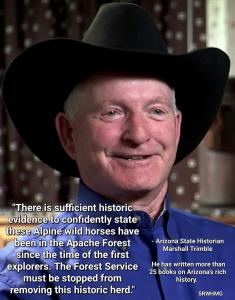Wild Horse Advocate groups outraged at Apache Sitgreaves National Forest (ASNF), as Newborn Foals are put at Risk
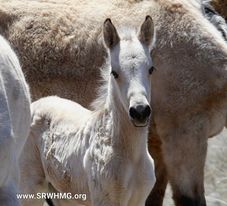
Two week old beautiful Alpine foal at risk
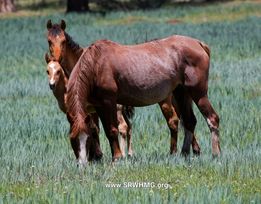
a small family close to the trapsite
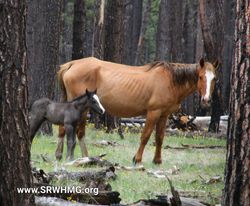
Two day old tiny foal at risk near trapsite
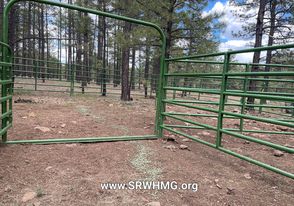
Trap pen in the Apache Forest.
At height of foaling season and without public notice, Forest Service resumes controversial capture of Alpine wild horses.
ALPINE, AZ, USA, May 25, 2023/EINPresswire.com/ --
Today, a coalition of wild horse organizations expressed outrage at the discovery of a United States Forest Service (USFS) contractor setting up bait and trap pens in the Apache Sitgreaves National Forest (ASNF) to capture historic Alpine wild horses in the high mountains of northeastern Arizona. This move by the USFS was implemented without public notice and comes during the height of foaling season, when tiny new foals are being born.
Yesterday, volunteers from the Alpine Wild Horse Advocates (AWHA) and the Salt River Wild Horse Management Group (SRWHMG), while photographing and recording the new foals in the forest, documented the contractor setting up the traps and baiting it with salt blocks and alfalfa pellets. During this time, the volunteers noted more than a dozen foals under two weeks old – including one-day old babies – as well as many heavily pregnant mares. Foaling season, as stated by the Bureau of Land Management (BLM), is March 1st through June 30th. During that time, all BLM roundup operations are suspended.
Arizona Veterinarian Jennifer F. Johnson, VMD stated "Even the very first foals of the year are not strong enough yet to survive the trailer ride from the wild to holding, let alone the brand newborns. The vulnerable foals can get stuck in panels or get trampled by panicked adult stallions in a trailer together. The stress of transport can also lead to pregnant mares spontaneously aborting their fetus; it is the worst possible time for the Forest Service to do this."
The Alpine wild horse herd garnered national attention when volunteers with AWHA and SRWHMG came across the bodies of 43 slain Alpine wild horses, all with brutal gunshot wounds, during last years removals. The massacre rocked the state and reinvigorated calls for protections for this historic herd. To date, the Apache Sitgreaves Forest Service has not found the perpetrator(s) of the heinous crime and has failed to take protections for these beloved horses seriously.
"The Apache Sitgreaves Forest Service chose not to humanely manage this historic herd using fertility control and as a result, is now seeing a growing population,” said Simone Netherlands, president of the SRWHMG. “This agency is not listening to the public, nor the science and instead is acting with blatant disregard to the welfare of the horses by capturing them at the most dangerous time possible.”
At the same time that the USFS is citing that the 400 horses must be removed because of environmental concerns, the agency is reauthorizing year round livestock grazing of 687 cows in the East Eagle alotment, in addition to 1000 cattle already authorized in the same area's the horses live. Click here for Environmental Assessment (EA).
The Forest Service has not responded to requests from wild horse management organizations to discuss humane management alternatives, like the successful fertility control program of a similar herd on the Salt River, which has led to a reduction in birth rate from 100 foals a year, to just one or two foals a year, for the past 3 years. This method is not only more humane, but also saves millions of dollars and preserves eco-tourism, which is an important boon for the small rural community of Alpine, AZ.
Sadly the removed Alpine horses will be sold online to the highest bidder, with no limitation on slaughter. Last year, the USFS captured and removed 215 Alpine wild horses. SRWHMG paid for and facilitated the rescue of 173 of them, who were placed in sanctuaries and good homes. At least two Alpine wild horses died in possession of the contractor, after SRWHMG already purchased them, but the Apache Sitgreaves Forest Service has not publicly disclosed a total death toll from last years capture operation, to this date.
Additionally, the groups are raising concerns about the Forest Service’s auction process. Prior to last year’s removals, the groups had documented and individually identified 370 Alpine wild horses in a database. After the removals, many of the lead stallions for the captured bands never appeared for bid in the online auction. One of those stallions, a pale buckskin horse named Hero, was identified at a ranch owned by a known associate of the roundup contractor Rail Lazy H. Under state law, all horses removed as stray livestock must placed for sale at a public auction.
Arizona’s State historian Marshall Trimble has done research into the historic archives for this herd. He states: "The Alpine wild horses, who live around the Coronado Trail, are possibly the most historic wild horses in Arizona since they were left behind by Francisco Vasquez de Coronado in 1540 when he blazed that very trail. “It is a historic mistake to get rid of them without more research, and a crying shame how they are being treated by our US government."
Below are videos taken by the horse advocates of small Alpine foals near the trap sites as well as video of one of the trap sites:
https://youtu.be/TmJ3gTOU9X8
https://youtu.be/8XQ1nNqTlyU
https://youtu.be/KQd9CfZQfyQ
Simone Netherlands
Salt River Wild Horse Management Group
+1 928-925-7212
email us here
Visit us on social media:
Facebook
Instagram
YouTube
Two day old precious foal close to the trap site.

